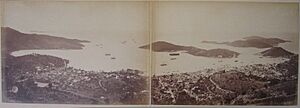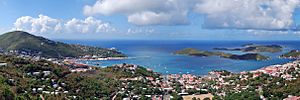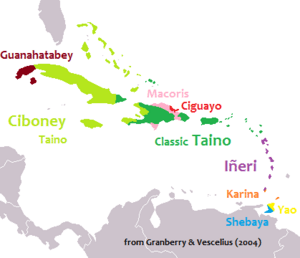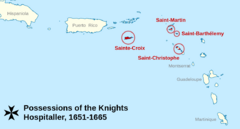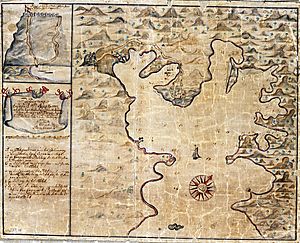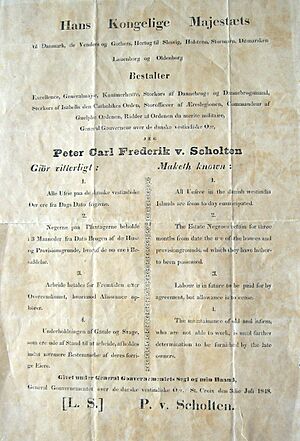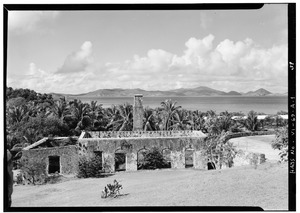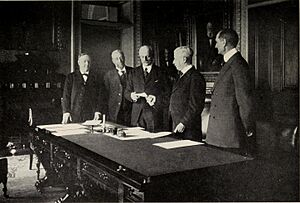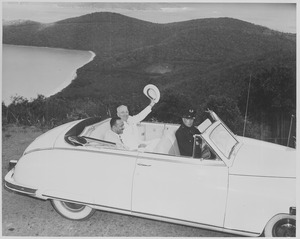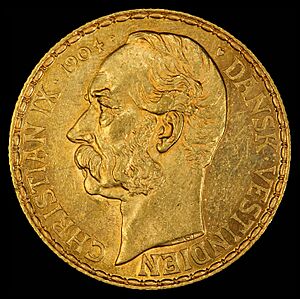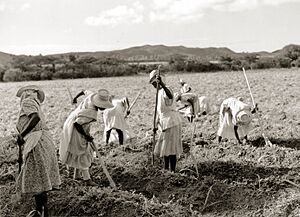History of the United States Virgin Islands facts for kids
The United States Virgin Islands, often called USVI, are a group of islands in the Eastern Caribbean. They include three main islands: Saint Croix, Saint John, and Saint Thomas. There are also about fifty smaller islands and cays. Like many Caribbean islands, their history involves native people, European settlers, and the Atlantic slave trade.
Before Europeans arrived, different groups of native people lived on the islands. These included the Arawak, Ciboney, and Kalinago peoples. Christopher Columbus first saw the islands during his second trip in 1493. Over the next hundred years, settlers from Europe claimed the land. Most native people either died or were forced to leave. The islands later became part of the triangular trade. Many enslaved people were brought there, starting in 1673.
The Danish West India Company took control of the islands between 1672 and 1733. In 1754, the King of Denmark took direct control, and the islands became the Danish West Indies. After a slave rebellion in 1848, slavery was ended. This caused the islands' farm economy to fail. Denmark tried to sell the islands many times. After long talks, the United States bought them in 1917. They officially became a U.S. territory in 1927.
Contents
Ancient History of the Virgin Islands
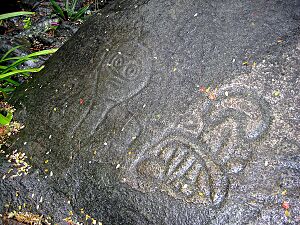
Archaeologists have found proof that people lived in the Virgin Islands for thousands of years. The oldest signs are pieces of pottery from about 250 BCE.
Different native groups lived on the islands over time. These included the Ciboney, Arawak, and Kalinago peoples. These groups were skilled at sea. They hunted, gathered food, and used dugout canoes for travel and fishing. The Ciboney are thought to be the first settlers, around 300–400 BCE. The Arawaks followed around 100–200 CE.
The Saladoid culture was present until about 600 CE. Then came the Ostionoid culture. More archaeological sites from this time show that the islands' population grew. Most rock art on the Virgin Islands is from the Ostionoid period, after 1000 CE. You can still see these carvings today. Some are at Virgin Islands National Park on St. John.
Around the 1300s, the Kalinago people started settling the islands. They were more warlike than the Arawak and Ciboney. They used bows with poisoned arrows, javelins, and clubs. The Arawaks, who were more peaceful farmers, often fled or were killed by the Kalinago. This happened before Christopher Columbus arrived in 1493.
An archaeological site at Salt River Bay shows that the Kalinago took over an Arawak religious center. Tools and everyday items made from bone, shell, and stone have been found. Pottery from the Arawaks and Kalinago also exists. When Europeans arrived, the Taíno language was spoken on the islands.
Early European Settlement: 1493–1733
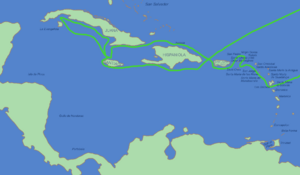
The first Europeans to visit the islands were with Christopher Columbus. During his 1493–1496 voyage, Columbus landed on Saint Croix. He then explored Saint Thomas and Saint John. He gave them Spanish names like Santa Cruz and San Tomas. The many small islands reminded him of Saint Ursula and her 11,000 virgin martyrs. So, he named the group Santa Ursula y las Once Mil Virgenes, which was shortened to Las Vîrgenes.
Columbus's first meeting with the Kalinago quickly turned into a fight. When Columbus left, he took six Arawaks to guide him. Columbus did not start a colony then. But many more battles followed between the Spanish and Kalinago. Diseases, forced labor, and violence greatly harmed the native populations. Spanish forces often raided the islands. They enslaved native people to work in mines. Many who were not captured fled to other Caribbean islands. Around 1550, Charles V of Spain declared the native tribes enemies. Most remaining native people then fled, were enslaved, or were killed.
Saint Thomas and Saint John were not settled until the 1600s. But Saint Croix had several colonial settlements in the 1500s. Its location near Spanish lands meant it was settled by "desperate English, French or Dutch settlers." Spanish ships often avoided St. Croix.
In 1625, the English and Dutch shared control of Saint Croix. Later, the French also settled there. In 1645, a fight between the Dutch and English made the Dutch leave. The French sided with the Dutch and moved to Guadeloupe. The English were then the only ones claiming the island. But in 1650, Spanish forces from Puerto Rico attacked them. The Spanish forced the English to flee. When the Dutch tried to return, they were also attacked by Puerto Rican authorities.
The French Governor General of St. Christopher, Phillippe de Lonvilliers de Poincy, learned the English were gone. He sent soldiers to take over the island. They defeated the Spanish. About 300 French settlers then moved to Saint Croix. The colony was never very successful. Control of the island changed hands several times. Due to many deaths and financial losses, the island was abandoned in 1696. The remaining settlers moved to Saint-Domingue.
Danish Rule: 1672–1917
The Danish West India Company

After a treaty in 1670, the Danish West India Company was formed in 1671. The company was allowed to take over any islands that were empty or suitable for farms. In 1672, they took Saint Thomas. Starting in 1673, enslaved people were brought from Africa to work on farms on St. Thomas.
The company tried to settle Saint John many times. In 1718, they finally succeeded by building a settlement in Coral Bay. By 1733, St. John had 1,295 people. Most of them (84%) were enslaved.
After a dry period in the 1720s, the Danish West India Company wanted more farmland. They looked at St. Croix, which had been empty since 1696. The French, who owned it, agreed to sell it to the Danish for 750,000 livres in 1733. The treaty said the islands could not be sold to another country without French permission. This rule became important much later. When the Danish bought St. Croix, about 150 British people and 400–500 enslaved people lived there. They were allowed to stay if they promised loyalty to the Danish king.
The Danish West India Company continued to have money problems. In 1754, the people of St. Croix asked King Frederick V to take direct control of the islands. The company's debts were very high.
Royal Control of the Islands
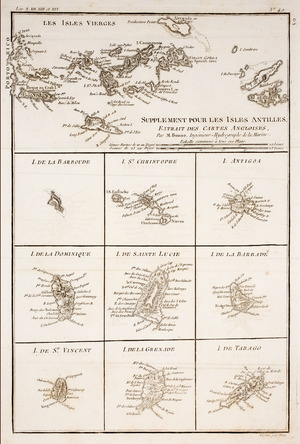
King Frederick V of Denmark–Norway took direct control of the islands in 1754. He took over all the company's money and debts. The islands became known as the Danish West Indian Islands. In 1766, the Danish West Indian rigsdaler coin was first made. It was used until 1849.
Sugar production in the Danish West Indies was the main part of the islands' economy. At its peak in the late 1700s, over half of St. Croix's land was used for growing sugar. Cotton, indigo, and tobacco were also grown. These farms relied almost entirely on slave labor.
British forces took over the Danish West Indies twice during the Napoleonic Wars. They were there from 1801–1802 and again from 1807–1815. Denmark was allied with Napoleon. England occupied the islands to stop France from using them for military purposes. The islands had little protection and quickly surrendered. The first occupation ended in 1802. The second invasion lasted until 1815. The islands were returned to Denmark in exchange for Heligoland.
Slavery and Freedom
Under the Danish West India Company, the islands relied heavily on large farms and slave labor. Trading posts were set up for sugar, enslaved people, and other goods. The harsh conditions and cruel treatment caused much unhappiness. In 1733, a long dry spell and a bad hurricane pushed enslaved people on St. John to revolt. In November 1733, about 150 enslaved people from the Akwamu tribe rebelled. They took control of the island. The Danish company asked for help from French and Swiss soldiers. The rebellion ended in August 1734. After this, rules for the colony's Afro-Caribbean population became stricter.
By 1778, about 3,000 enslaved Africans were brought to the Danish West Indies each year. In 1789, enslaved people made up 88% of the islands' population. As trade grew, more enslaved people worked in ports instead of on farms.
In 1792, King Christian VII tried to stop the transatlantic slave trade. But it was not actually ended until 1803. The delay was to give farm owners time to "stock up" on enslaved people. Even after 1803, slavery continued within the islands. By 1838, over 100,000 enslaved people had been brought to the Danish West Indies. Some were then sold to other colonies.
Other Caribbean countries began to end slavery. Great Britain did so in 1833 and France in 1848. The Governor General of the Danish West Indies, Peter von Scholten, asked Denmark to free enslaved people in 1833. His views were likely influenced by his free-colored partner, Anna Heegaard. His request failed. But in 1834, von Scholten allowed enslaved people to buy their freedom without the owner's permission.
In 1848, King Christian VIII planned to end slavery slowly. He said every child born would be free. But enslaved people were not happy with this. General Buddhoe (Moses Gottlieb) and Admiral Martin King led a rebellion. On July 2, 1848, about 8,000 people gathered outside Fort Frederik. On July 3, General Buddhoe demanded freedom. He said they would burn down Frederiksted if freedom was not declared. Governor Von Scholten quickly announced that "all unfree in the Danish West Indies are from today emancipated." Today, July 3 is celebrated as Emancipation Day.
The Governor-General did not actually have the power to end slavery. Slave owners and Danish officials were angry. Von Scholten was investigated and lost his pension. But the Supreme Court later cleared his name. In 1853, the Danish Parliament paid former slave owners money for their losses.
After slavery ended in 1848, life for formerly enslaved workers did not get much better. They were paid very little. They struggled to support themselves. Most still worked on the same farms. A law in 1849 set a working wage. But it also said workers could only change jobs once a year. This led to more unrest. In 1878, the 1878 St. Croix labor riot happened. Most of Frederiksted and about 50 farms were burned. Conditions and pay improved a little after this. But the freed people were still treated unfairly.
Selling the Islands
After slavery ended, the islands' farm economy failed. Sugar from St. Croix faced strong competition. Shipping and trade on St. Thomas had already slowed down. The islands became a financial burden for Denmark. Meanwhile, the United States became interested in the islands for military reasons. They wanted to strengthen their position in the Caribbean. Talks to sell the islands to the U.S. began in 1866 and continued until 1917.
In 1866, the U.S. feared that Prussia and Austria might take the islands. So, William H. Seward started talks with Denmark. A treaty was signed in 1867. The U.S. would buy St. Thomas and St. John for $7.5 million in gold. The islands voted overwhelmingly to approve the sale. But the U.S. Senate did not approve the treaty by the deadline in 1870. So, the deal fell through.
American interest in the islands returned in 1899. Rumors spread that Germany might buy them. The U.S. offered Denmark $3.5 million in gold for all three islands. Talks about the price and the rights of the islanders followed. In 1902, an agreement was reached. The U.S. Congress approved it. But in Denmark, the lower house approved the sale. The upper house was split evenly, 32 votes for and 32 against. So, the treaty was not approved. Some believed German influence caused this failure.
During World War I, the U.S. again became interested in the islands. They feared Germany might take them for a U-boat base. The islands were important because they were near the new Panama Canal. The U.S. offered $25 million. The third sales treaty was signed in 1916. The islands voted 99% in favor of the sale. Denmark also held a vote, and 64% voted for the sale. The treaty was approved by Denmark's parliament and signed by both the Danish King and the U.S. President. The United States officially took control of the islands on March 31, 1917. Danish rule ended after nearly 250 years. The territory became the United States Virgin Islands.
American Period: 1917–Present


After the United States took control, the islands were renamed the Virgin Islands of the United States. May 31 is still celebrated as Transfer Day.
Most residents became U.S. citizens by 1936. Today, the U.S. Virgin Islands has many different ethnic groups. These include Virgin Islanders, people from other Caribbean islands, Puerto Ricans, and Americans. People born in the U.S. Virgin Islands are U.S. citizens. They can travel between the islands and the U.S. mainland without a passport.
Rear Admiral Kitten asked Percival Wilson Sparks to design a new flag for the territory. Sparks' wife, Grace Itah Maria Joseph Sparks, and her sister, Blanche Joseph Sasso, sewed the first flag. They became known as the Betsy Rosses of the Virgin Islands.
Water Island, near St. Thomas, remained privately owned until 1944. The U.S. bought it for $10,000. From 1944 to 1996, Water Island was federal property. Control was given to the U.S. Virgin Islands government in 1996 for $25 million. Old sites have been found on the island, including remains from pre-colonial times and World War II forts.
How the Government Works
The U.S. Congress passed a law in 1917 to set up how the territory would be governed. This law was temporary. It was replaced in 1936 by the Organic Act of the Virgin Islands. The Revised Organic Act of the Virgin Islands then replaced this in 1954.
The Virgin Islands officially became an unincorporated U.S. territory in 1927. Their first civilian governor, Paul Martin Pearson, was appointed in 1931. The islands were under direct U.S. government control until 1968. That year, residents could first elect their own governor. In 1972, they elected their first non-voting delegate to Congress.
In 1976, President Gerald Ford signed a law. This law gave citizens the right to create their own government and a constitution. Several attempts have been made to write a constitution. But none have succeeded. The Revised Organic Act of the Virgin Islands from 1954 still defines the islands' government.
The Fifth Constitutional Convention of the U.S. Virgin Islands passed a proposed constitution in 2009. President Barack Obama sent it to Congress. But the President's office, Congress, and the U.S. Department of Justice had concerns. Congress did not approve it. They asked the convention to revise the document. Delegates met in 2012 but did not agree on a new draft.
Economy of the Islands
After the U.S. bought the islands, the Danish West Indian daler was still used as money until 1934. Then, the United States dollar became the official currency.
The 1930s brought big changes to the economy. The end of Prohibition in the U.S. increased demand for workers. Also, a submarine base was built on St. Thomas during wartime. There were not enough workers on the islands. This created a need for workers from other Caribbean islands. This led to many people moving to the U.S. Virgin Islands. The government also started to focus on tourism and light industry.
After World War II, tourism became very important. Today, it is the largest industry in the USVI. The islands have about 105,400 permanent residents. But they welcome 2.5–3 million tourists each year, mostly from cruise ships.
More to Explore
- Outline of the United States Virgin Islands
- Danish West Indies
- History of the Caribbean


